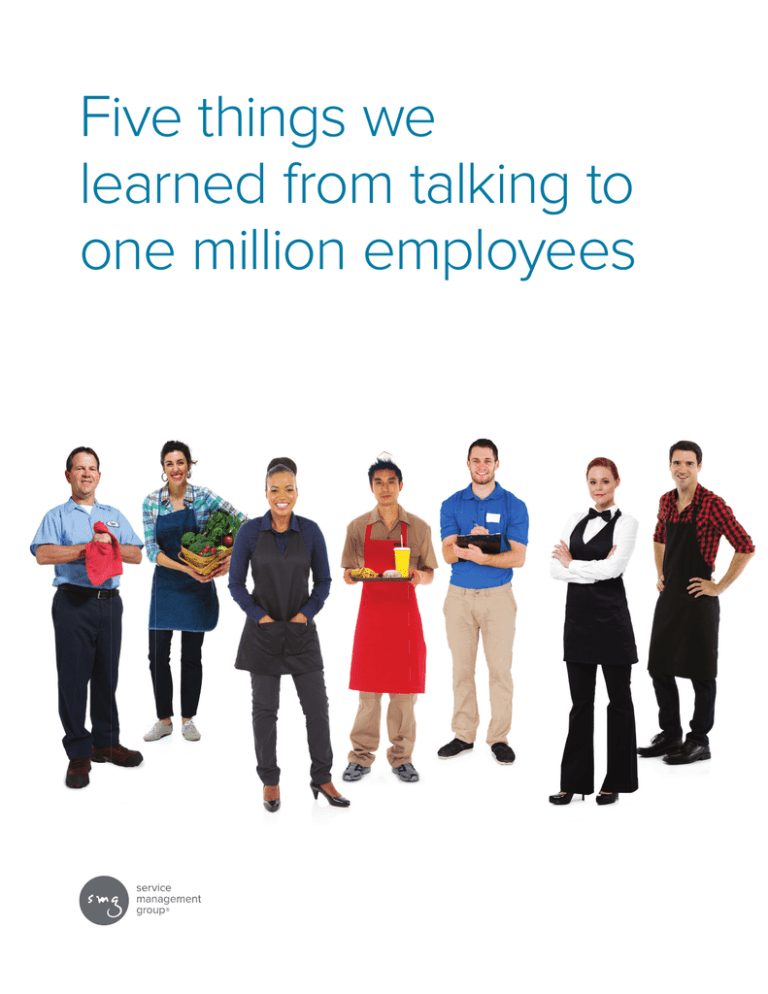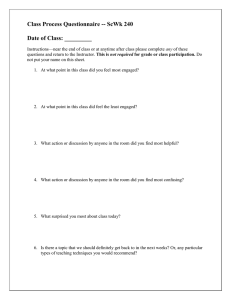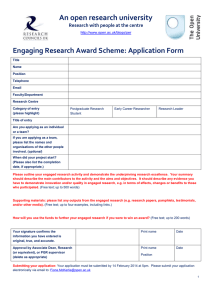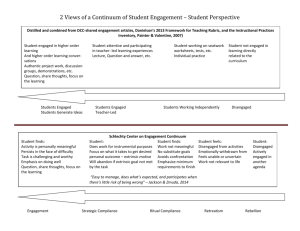
Five things we
learned from talking to
one million employees
Business is not just about numbers.
It’s not just about market analysis or economic indicators. Business is
about people. People interacting with other people. Leaders interacting
with employees. Employees interacting with customers.
Today, you can’t just build a better widget or brew a better cup of coffee.
Yes, those things still matter. Customers buy products from companies,
after all. But they do business with people.
That’s why it’s crucial to have employees who are engaged with their work.
The more engaged your employees are, the more your customers come
back for more widgets and more coffee.
We know that because we talk to people. A lot of people. Over the past
three years, we’ve talked to a million employees who work for dozens
of service companies. Companies that serve hundreds of millions of
customers every day.
We also talk to customers. More than 750 million of them, in fact.
And they’ve told us, again and again, that people matter. Customers
come back more often and spend more money at locations where
employees are engaged.
Using data collected from those one million employees at dozens of
service companies over the course of three years, we conducted a
meta-analysis. Here are five things we’ve learned from those one million
employees. Things that can increase employee engagement, build
customer loyalty, and improve the one number that really does matter — the one on the bottom line.
page 2
© 2015 Service Management Group | Confidential | All rights reserved
Five things we learned from talking to one million employees
THING #1: Engaged employees will drive financial performance
Engaged employees are more loyal, helping create highly
satisfied and loyal customers. And highly satisfied, loyal
customers lead directly to growth in sales and profits.
That progression is called The Service Profit Chain. It’s a
concept that was developed at Harvard Business School
by a group that includes one of our company’s founders,
Len Schlesinger. But The Service Profit Chain isn’t just
an academic theory. When put into practice, it has a
pretty significant impact on financial performance.
For instance, locations with highly engaged employees
have lower turnover than less engaged locations in the
same company. That means those stores don’t have
to spend as much time and money hiring and training
new staff. It has a big impact — sometimes netting out
to millions of dollars in savings.
And it doesn’t stop there. Locations with highly engaged
employees have more highly satisfied customers, and
those customers are more likely to recommend the
business to others — 5% more likely.
More highly satisfied customers making more
recommendations leads to increased sales. Locations
with highly engaged employees average comp sales
2% higher than their less engaged counterparts.
That’s what sound theory looks like in practice.
The takeaway
Engaged employees help create highly satisfied
and loyal customers, and that will drive the bottom
line — cutting turnover and boosting sales.
FIGURE 1
Highly engaged employees impact financial performance
Top 20% locations versus bottom 20%
%
+5
Customer
%
+5
Customer likelihood
overall satisfaction
to recommend
%
+2
Comp sales
%
-18
Turnover
© 2015 Service Management Group | Confidential | All rights reserved page 3
THING#2: Jobs need to mean something
Most engagement surveys only focus on job basics.
Rarely do they highlight the meaning of work. We talk
to employees about teamwork, managerial support,
recognition, empowerment, and growth opportunities.
It helps us bridge the gap between how they feel about
the job and how working makes them feel.
Workers want to connect to their employer’s goals.
They want to know they have a place in achieving
those goals. They also want to brighten the day for
the customers they interact with. They want to know
the product or service that customer is buying means
something to that customer.
The number one thing that the one million employees
we’ve talked to told us they want is “rewarding work.” In
fact, having the chance to do rewarding work, which service
company employees directly connected to interacting with
customers, is twice as important as anything else.
The second thing employees told us they wanted was
to have a chance to use their personal strengths in their
work. And the third was to have opportunities to learn
and to grow on the job.
FIGURE 2
Aspects of the workplace that matter most
21%
Work is rewarding
11%
Opportunities to use talent
11%
Opportunities to learn/grow
7%
Receive recognition
6%
Provided information/tools to do my job
6%
Provided training to do my job well
6%
Team members are trustworthy
Notice how none of these qualities are limited to a certain
type of job or level in the organization? That’s because
engagement can happen anywhere — from the break
room to the board room.
What employees want — really want — is a job that offers
personally fulfilling opportunities, leverages skills, and provides a chance to grow. Sounds like a good job, doesn’t it?
The takeaway
Workers want jobs with a purpose. Whether that means
making customers happy or growing within the company,
rewarding work engages employees more than anything.
THING#3: Millennials are different…and the same
Workplaces are changing because the workforce is
changing. That’s no surprise. “The Rise of the Millennial
Workforce” has made headlines for years, usually
What needs to be improved
followed by dire warnings of the changes these new
% Poor management
30
workers will impose on management. We’ve done our
% Don’t feel valued
20
own
research on millennials, collaborating with The
% More support needed
19
Boston
Consulting Group and Barkley on a 2012 study,
%
Lack of communication
The Millennial
Consumer.
19
15% Teamwork
But here’s something surprising we found about
%
Better staffing/more hours
10
millennials in the workplace: they really aren’t all that
%
More feedback
10
different from other generations
in their attitudes toward
%
Better
scheduling
7
workplace
engagement.
Our surveys have found that
7%
millennials
want: Higher pay
respect
6•% Work that’s More
rewarding
• Opportunities to use talent
• Opportunities to learn/grow
What you like best
page 4
26%
22%
Positive manager interaction
Great coworkers
Sound familiar? It should. Millennial drivers of
engagement are in line with drivers for other generations.
Poor management
Still, millennials do differ in a couple ways. TheyDon’t
don’tfeel valued
display the same long-term commitment to organizations
More support needed
that other generations do. This means, when compared
Lack of communication
to older generations, fewer millennials expect to be in
Teamwork
their current job for more than a year.
Better staffing/more hours
Millennials also expect engagement with their workplace
More feedback
to have a technological spin. The easy way to think
of scheduling
Better
that: When it comes to communication, if it can be
digital,
Higher pay
it should be. Millennials are more likely to be checking
More respect
their phones than the bulletin board.
The takeaway
Don’t believe the hype about millennials changing the
nature of work. They want what everyone wants at work.
But they’d also like their companies to use the best
technology available to help them get the job done.
© 2015 Service Management Group | Confidential | All rights reserved
11%
Five things we learned from talking to one million employees
Opportunities to learn/grow
7
%
6
%
Provided information/tools to do my job
6
%
Provided training to do my job well
6
%
Team members are trustworthy
Receive recognition
THING#4: Money doesn’t drive engagement
You could look back at Thing #2 to see what drives
engagement. But we’ll save you the time. And maybe
some money, too. The top three things on that list didn’t
say anything about “money.” Instead, they said things
about “rewarding work,” “consistent opportunities to
use personal strengths,” and “opportunities to learn
and
Work is rewarding
21% grow.”
%
Opportunities
to Financial
use talent incentives aren’t great
11 makes
That
sense.
% Opportunities to learn/grow
long-term
drivers of engagement. Employees, when
11
%
happy
and engaged, feel
like they’re
part of something
Receive
recognition
7
bigger
than a paycheck. And when they’re unhappy and
%
Provided information/tools to do my job
6
disengaged, it’s rarely about money then, either.
support. And fourth was poor communication. You
have to go five spots farther down the list before
“higher pay” shows up.
When we talked to highly engaged employees, the
things
theyneeds
liked about
their job paralleled the things
What
to be improved
disengaged employees disliked. Tops on their list was
management
30% Poormanager
“positive
interaction.” Then “great coworkers.”
% Don’t feel valued
20 “fun work environment,” followed by “getting to
Then
More support needed
19% customers.”
know
The paycheck didn’t even make the
% Lack of communication
19
top 10.
So
employees say are the biggest
Team members are trustworthy
6%what do disengaged
factors contributing to their disengagement? Tops on
the list was poor management. Second was feeling
unappreciated. Third, they said they needed more
15% Teamwork
The
Better staffing/more hours
10% takeaway
More feedback
When
engagement, more pay
10% looking to drive employee
%
is 7
rarely the answer.
Thescheduling
first priority is to make sure your
Better
managers
are paying
attention
to what employees want:
Higher
pay
7%
% communication,
better
an
enjoyable
work environment,
More respect
6
FIGURE 3
FIGURE 4
When asked what could be improved about their work
experience, disengaged employees mentioned:
What needs to be improved
When asked what they like best about their work
Poor management
experience, engaged employees mentioned:
What you like best
Don’t feel valued
30%
20%
19%
19%
15%
10%
10%
7%
7%
6%
26%
22%
19%
15%
13%
10%
6%
4%
3%
2%
6%
Provided training to do my job well
Poor management
Don’t feel valued
More support needed
Lack of communication
Teamwork
Better staffing/more hours
More feedback
Better scheduling
Higher pay
More respect
and opportunities to closely serve your customers.
Positive manager interaction
More support needed
Great coworkers
Lack of communication
Fun work environment
Teamwork
Getting to know customers
Better staffing/more hours
Teamwork
More feedback
Support
Better scheduling
Growth opportunities
Feedback
Higher pay
More respect
Respect
Scheduling
What you like best
26% Positive manager interaction
22% Great coworkers
19% Fun work environment
15% Getting to know customers
13% Teamwork
10% Support
6%
Growth opportunities
%
4
Feedback
© 2015
Management Group | Confidential | All rights reserved 3% ServiceRespect
2%
Scheduling
page 5
THING#5: Don’t ask if you don’t intend to act
It’s crucial to know how engaged your frontline
employees are. That’s why you should survey them.
At least once a year. Maybe more. But if you stop there,
you’re not going to make things much better. In fact,
you’ll likely make them worse.
Our data shows that employees recognize and respond
to follow-through. When managers act on the results
of engagement surveys, employees become more
engaged. Substantially more engaged.
Workplaces with the highest level of follow-through after
an employee engagement survey show an 18% increase
in engagement on the next survey. Want to guess what
happens when there is little follow-through? In that case,
there’s actually a decrease in engagement — a 21% drop.
Impact of follow-through on employee engagement
With lowest level
of follow-through
Employee engagement
That means several things:
• Identifying the business need and developing
a plan for addressing it
• Setting a goal and creating a system to follow
through on that goal
• Making that goal an organizational priority
Employees have told us what drives their engagement.
So, if increasing employee engagement is a worthy goal,
and there’s financial proof that it is, then it’s important
to know how to follow through on achieving it. Really
important.
It bears repeating: Don’t ask if you don’t intend to act.
The takeaway
FIGURE 5
page 6
That’s why you need more than a survey — you
need a holistic approach to drive engagement.
With highest level
of follow-through
Collecting feedback isn’t everything. Leaders also
have to commit to action even before they ask
employees about engagement. Then, they have to
follow through with some action or response once the
surveys are in. Engagement has to be a year-round,
organizational priority.
18%
21%
© 2015 Service Management Group | Confidential | All rights reserved
Five things we learned from talking to one million employees
5-star human experiences matter
Business might not really be just about numbers. But the
numbers do matter, especially when they relate to people.
A service company’s employees are often its biggest,
and most important, investment. Millions are spent hiring,
training, and retaining service-oriented team members.
Because when companies differentiate on service — with
engaged employees providing 5-star human experiences
to customers — they see big rewards. It’s the reason
the best-performing companies have made employee
engagement a top priority. The linkage between a truly
engaged workforce and better financial performance is
clear and consistent.
And while having a system in place to get feedback
from employees is a worthy cause, it’s not worthwhile
if it stops there. Businesses need a holistic approach
that follows through by turning feedback into insights
and insights into results.
To learn more about how
SMG’s employee engagement
solution can drive more 5-star
human experiences, email
insight@smg.com.
Know more. Do better.
SMG’s hundreds of millions of conversations with
customers and employees is more than just talk.
It’s perspective. A unique one that allows us to see
what every transaction looks like — from both sides
of the register.
Combining customer experience measurement with
employee engagement is just one more way SMG
helps clients know more and do better.
© 2015 Service Management Group
|
Confidential
page 7
Americas
Kansas City | 1737 McGee Street | Kansas City, Missouri 64108 | smg.com
Boston | 65 Franklin Street, 2nd Floor | Boston, Massachusetts 02110 | locately.com
EMEA Abbey View
|
38-40 The Maltings, St Albans, Hertfordshire AL1 3HL
Asia-Pacific Oak Minami-Azabu 2F
|
3-19-23 Minami Azabu
|
Minato-Ku
|
|
uk.smg.com
Tokyo Japan 106-0047
|
jp.smg.com
Connect with us
© 2015 Service Management Group
|
All rights reserved
|
Do not share or duplicate confidential content, in whole or part, without written consent






